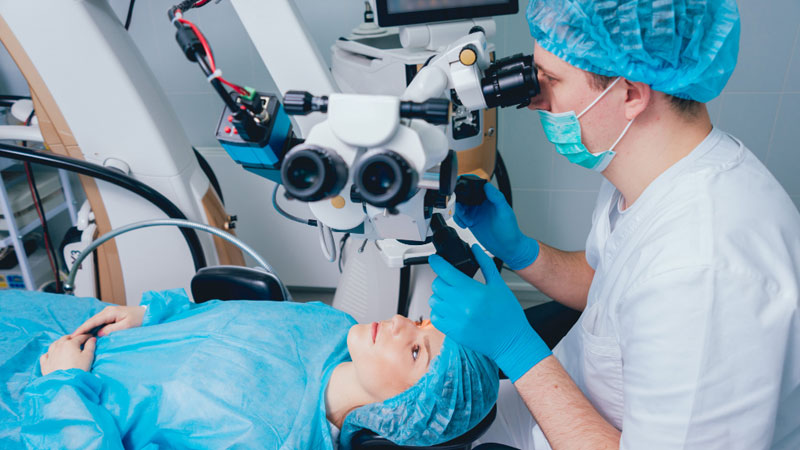
Cataract, also simply called Motiyabind in Hindi, refers to the clouding of the eye’s natural lens that distorts vision and makes the sight blurry, hazy or dull.
The natural lens is right behind the coloured part of the eye (Iris). In a healthy eye, this lens remains crystal clear and focuses light precisely onto the retina, a thin light-sensing layer at the back of the eye.
In cataract, when natural lens turns cloudy, the incoming light doesn’t appear sharply focused and is often described as looking through a foggy window, with even greater difficulty
The eye’s natural lens is mostly made of water and special proteins, arranged in a highly organized way that keeps it clear. With age or due to certain health and lifestyle factors, these proteins may clump together or the lens fibers can undergo changes. This causes light to scatter instead of focusing properly, leading to cloudiness.
The process is usually gradual, due to which cataract remain unnoticed or undiagnosed in most people. However, the problem seems to exist when simple tasks like reading, driving, or recognizing becomes difficult.
While age is the biggest risk factor for cataract/ motiyabind, it can also develop earlier or progress faster in people with certain conditions or lifestyle habits, such as:
Although most cataracts are age-related, children can also develop them—either present at birth (congenital cataracts) or appearing early in life due to genetic conditions, infections, or trauma.
Cataracts (Motiyabind) are classified based on which part of the lens is affected and the extent of clouding. Proper identification of the type of Cataract helps determine how fast it may progress:
Cataracts (Motiyabind) usually starts with mild, slowly worsening symptoms. Watch out for:
To determine if there is motiyabind, an eye doctor or ophthalmologist examines the eye through a combination of different tests.
Surgery is the only definitive treatment once vision problems starts interfering with everyday activities like reading, driving (especially at night), or work. Cataract surgery involves replacing the cloudy lens with a clear artificial intraocular lens (IOL) to restore clear vision.
It’s important to note: There are no eye drops, diets, or exercises that can reverse an existing cataract (motiyabind). Lifestyle changes such as wearing sunglasses, controlling diabetes, quitting smoking, and maintaining good eye health may help slow the progression but cannot clear clouding that has already formed.
In the present times, cataract surgery has become much more advanced and a quick day-care procedure for the removal of the cloudy lens and replacing with a clear artificial lens (IOL).
The most common approach for cataract surgery is:
The standard approach is Microincision phacoemulsification with active fluidics: a very small incision is made, ultrasound energy breaks the cloudy lens into tiny fragments, and those pieces are gently removed. A folded IOL is then placed where the natural lens used to sit. Stitches are rarely required.
The cost of Cataract Surgery depends on many factors including the type of cataract (motiyabind) for which the surgery is required, type of surgery required (manual, Phacoemulsification, Femto Laser-assisted), use of specialized equipment, managing existing conditions, choice of IOL lenses (Monofocal, Multifocal, Toric, EDOF), as well as the facility where the surgery is to be performed and the surgeon performing the surgery
For instance, cataract (motiyabind) surgery in Mumbai at a specialized eye care facility can be affordable in comparison to the surgery at a major hospital in New Delhi, the capital city.
Primarily the majority of people are provided monofocal IOL lenses, for clear distance and near vision. However the other alternatives for lenses are:
Monofocal (Distance) – For crystal clear distance vision
Monofocal (Near) – For clear near vision
Monovision – For clear distance vision from one eye and near from the other
Toric IOLs – For correction of pre-existing astigmatism. It’s a power of a lens rather than a separate type of lens and may it may not be required in an individual.
Multifocal/extended-depth-of-focus (EDOF) – For a range of focus and reducing dependence on glasses but may cause glare/ halos in some patients.
It is necessary to consult an expert ophthalmologist to identify the best set of lenses after cataract surgery according to your need and preference.
The surgery for Cataract (Motiyabind) is among the most successful and safest surgeries in advanced eye treatment and care. With highest success and lowest risk for complications, cataract surgery is one of the most performed surgeries for vision restoration, especially in the elderly. However, some of the issues that may arise due to cataract surgery are inflammation, infection, swelling, temporary rise in eye pressure, or extremely rare retinal detachment.
Most of the people having undergone a cataract surgery experience surprising improvement in vision and clarity within the first few days of the surgery itself.
Recovery is generally smooth and quick. Most people return to normal activities in 2 days, provided they follow the recommended precautions:
There is no specific “right” time for cataract surgery. The decision depends on how much cataract is interfering with your daily life. Surgery is usually recommended when:
Cataract or simply motiyabind is a natural age-related condition where the lens of the eyes becomes cloudy, leading to blurred vision, glare, and faded colors. While early cataracts may be managed with glasses and better lighting, the only definitive treatment is surgery.
Modern cataract surgery is safe, highly effective and restores clear vision by replacing the cloudy lens with a clear artificial one. If you notice persistent blur, glare, or halos, especially at night, it’s important to schedule an eye examination. Early detection ensures timely treatment, protecting your vision and quality of life.
For expert cataract (motiyabind) surgery in Mumbai, contact or visit Global Eye Clinic, a specialized eye clinic in Ghatkopar, Mumbai that offers advanced diagnosis and treatment for different types of cataracts.
Category : Cataract Surgery in Mumbai